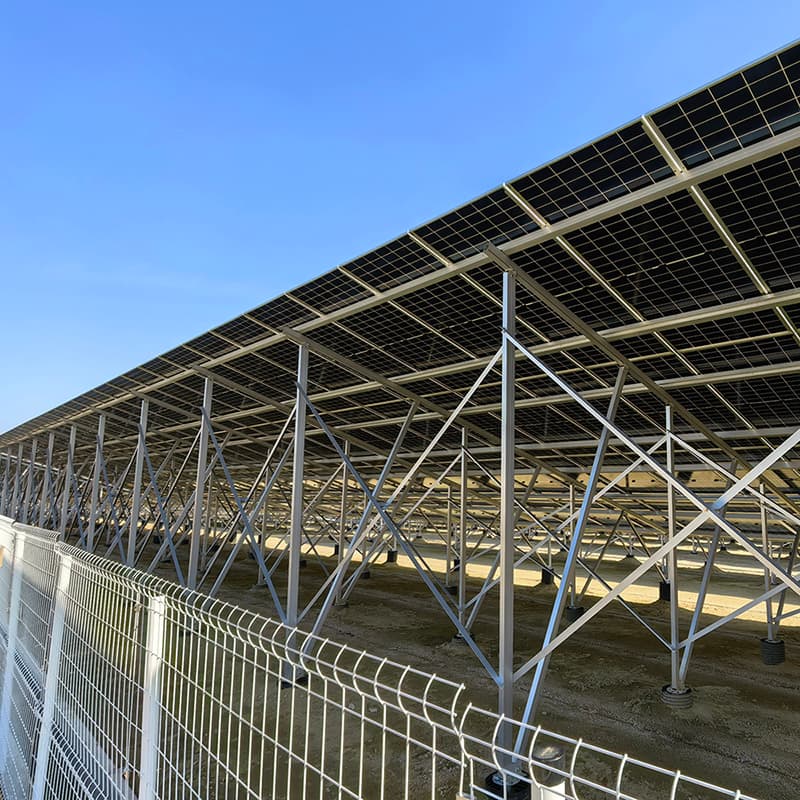


فهم أنظمة دعم الطاقة الشمسية الأرضية: الاختلافات في التصميم والفوائد
هياكل دعم أرضية للألواح الشمسية توفر أساسًا ثابتًا لمصفوفات الطاقة الكهروضوئية، مما يوفر مرونةً في مختلف التضاريس ومتطلبات المشاريع. تتوفر تكوينات تركيب متعددة، كل منها مصمم خصيصًا لتلبية احتياجات الأداء والبيئة والميزانية.
1. أنظمة التركيب ذات الزاوية الثابتة
التصميم: زاوية إمالة دائمة يتم ضبطها وفقًا لخط العرض الجغرافي.
الفوائد الرئيسية:
التركيب والتشغيل الاقتصادي.
صيانة بسيطة بسبب المكونات الثابتة.
مقاومة للطقس القاسي.
مفضل على نطاق المرافق مزارع الطاقة الشمسية.

2. أنظمة موسمية معدلة يدويًا
التصميم: تعديلات زاوية دورية لتتماشى مع مسارات الشمس المتغيرة.
الفوائد الرئيسية:
تحسين إنتاج الطاقة بشكل معتدل (5-15%) مقارنة بالأنظمة الثابتة.
ترقية بأسعار معقولة من الحوامل الثابتة.
قابلة للتكيف مع التغيرات الموسمية في موقع الطاقة الشمسية.
3. أجهزة تتبع الطاقة الشمسية أحادية المحور
التصميم: تتبع حركة الشمس اليومية بشكل آلي من الشرق إلى الغرب.
الفوائد الرئيسية:
زيادة كبيرة في الإنتاج (20-30%) مقارنة بالصفوف الثابتة.
مثالية للمنشآت التجارية والصناعية.
كثافة الطاقة المحسنة لكل مساحة من الأرض.
4. أجهزة تتبع الطاقة الشمسية ثنائية المحور
التصميم: القدرة الكاملة على متابعة الشمس عبر المسارات اليومية والموسمية.
الفوائد الرئيسية:
أقصى قدر من حصاد الطاقة (ما يصل إلى 40٪ مكاسب).
ضروري للمناطق ذات خطوط العرض المرتفعة.
مثالية للتطبيقات الدقيقة مثل المرافق العلمية.
5. حوامل الأعمدة المرتفعة
التصميم: مجموعات من الألواح المرتفعة على دعامات رأسية.
الفوائد الرئيسية:
بصمة أرضية ضئيلة على المناظر الطبيعية الوعرة.
تقليل التدخل في النباتات.
التوافق مع آليات التتبع.
6. منصات الصابورة غير الغازية
التصميم: قواعد مؤمنة بالوزن مما يمنع اضطراب الأرض.
الفوائد الرئيسية:
عدم اختراق الأسطح المحمية.
نشر سريع بدون أسس.
إمكانية النقل المعياري للمواقع المؤقتة.
لماذا تختار المصفوفات الشمسية الأرضية؟
تنظيم حراري فائق: يعمل التبريد الطبيعي على تعزيز الأداء.
تحديد المواقع بدقة: تحسين المحاذاة غير المقيد.
التكوينات القابلة للتوسعة: زيادة السعة المبسطة.
خدمة يمكن الوصول إليها: إمكانية الوصول إلى الصيانة على مستوى الأرض.
تجنب القيود المفروضة على السطح: يزيل المخاوف الهيكلية.
ملاءمة المشاريع الكبيرة: مثالية للنشر على مستوى المرافق.
اختيار النظام الأمثل
تُحدد العوامل الخاصة بكل مشروع - بما في ذلك المعايير المالية، وخصائص الموقع، وأهداف الطاقة، والقيود المكانية - الحل الأمثل. فبينما توفر أنظمة الزاوية الثابتة موثوقيةً معقولة التكلفة، تُحقق خيارات التتبع إنتاجيةً عالية. وتحمي التصاميم المُثبّتة المواقع الحساسة، وتتغلب حوامل الأعمدة على التضاريس الصعبة.
هل تحتاج إلى إرشادات لتطبيقك الخاص؟ استشر خبراء هندسة الطاقة الشمسية لدينا.